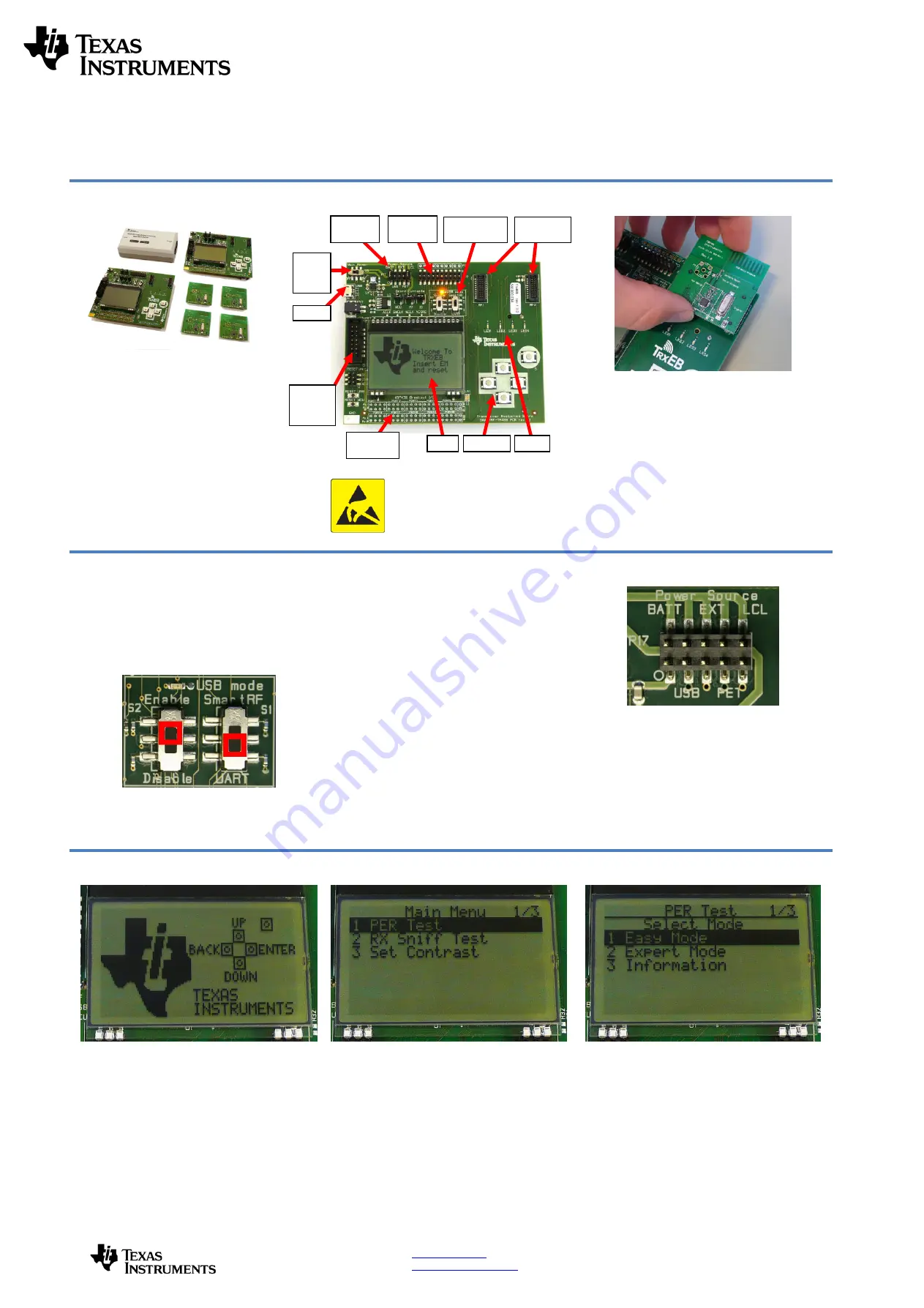
SWRU292A
January 2012
Web sites:
www.ti.com/lprf
E2E Forum:
www.ti.com/lprf-forum
Make sure to subscribe to the Low-Power RF
Newsletter to receive information about updates to
documentation, new product releases, and more.
Sign up on the TI web pages.
CC11xL 868/915 MHz Development Kit Quick Start Guide
Opening the Box and Running the Packet Error Rate Test
1. Kit Contents
2 x SmartRF
™
Transciever EB (TrxEB)
2 x CC110LEM 868/915 MHz
1 x CC113LEM 868/915 MHz
1 x CC115LEM 868/915 MHz
1 x MSP430 Debug Probe (FET)
2 x Micro USB Cables
1 x Standard USB Cable
1 x 14-pin Flat Cable
4 x 1.5 Volt AA Batteries
Documentation
2. TrxEB Overview
Caution!
The kit contains ESD sensitive
components.
Handle
with
care
to
prevent
permanent
damage.
To
minimize risk of injury, avoid touching
components
during
operation
if
symbolized as hot.
3. Plug the EM into the TrxEB
Insert
a
CC110LEM
into
the
TrxEB.
The
connectors will only fit in one position so that the
EM cannot be inserted the wrong way. Do not
use excessive force on the EM.
The EM has a PCB antenna, so there is no need
for an external antenna.
You can also use CC113L and CC115L for the
Per test, but note that CC113L is a receiver only
and CC115L is a transmitter only.
4. Select Board Mode
Use the switches S1 and S2 to select the
operating mode of the board. For the sake of this
quick start guide, please select “Enable” and
“UART”. This configuration will make it possible
to communicate directly with the MSP430 over a
virtual COM port on the PC.
5. Power Options
There are several ways of applying power to the
TrxEB.
2 x 1.5 V AA batteries
USB
External Power Supply
MSP430 Debugger
For the batteries and USB, there are voltage
regulators on the TrxEB that will set the on-board
voltage to 3.3 V. The external power supply
should set a voltage that does not exceed 3.3 V.
By default, the MSP430 debugger supplies 3.0 V.
Note that there should only be one active
power source at any one time.
Warning!
To minimize risk of personal injury or
property
damage,
never
use
rechargeable
batteries to power the board. Do not leave the
EVM powered when unattended.
6. Select Power Source
Depending on the power source, make sure
you connect jumpers to the appropriate pins
on the “Power Source” header. For instance,
if you use batteries, use a jumper to short-
circuit pin 1 and 2 on the header. The last
jumper in the row (pin 9-10) should always
be mounted, unless the MSP430 FET is
used as the power source.
7. Welcome Screen
Turn on power with the Main Power switch. You
should now see the Texas Instruments logo and
a short description of the buttons on the LCD.
Pushing any of the five buttons on the board will
take you to the main menu.
NB! If you don’t see anything on the screen –
don’t panic.
First, make sure the mode switches
are in the correct positions (see step 4 above).
Secondly, the first build of TrxEB unfortunately
uses a connector that doesn’t fit exactly to the
pins of the LCD. It should be sufficient to tilt the
LCD slightly to get a snug fit with the connector.
8. Packet Error Rate Test
Select the PER (Packet Error Rate) test by
highlighting the selection using the up/down
buttons. Confirm your selection by pressing
Enter (right button).
9. Select Test Mode
The PER test can be run is several modes. Easy
Mode sets up a one-way test and uses default
settings. This test is convenient for practical
range testing.
The other test modes are described in the
“
Software Examples for CC112x, CC11xL and
CC1101 User’s Guide
”.
To proceed, highlight “Easy Mode” and press
Enter (right button).
EM
Connectors
MSP430
Breakout
USB
EM
Breakout
Main
Power
Switch
Power
Selection
Board Mode
Switches
LCD
Buttons
LEDs
MSP430
Debug
Interface





















